 Contents of ChessBase Magazine 102
Contents of ChessBase Magazine 102
By Frederic Friedel
The ChessBase Magazine 102 CD contains an unusual number of directories, which appear on your ChessBase desktop when you start the CD from there. The magazine should appear something like in the picture below on your computer screen. Since we have entered the era of ChessBase 9.0 we will provide instructions and screendumps created with this program. Note that if the contents of CBM 102 are not automatically displayed you can get them by clicking on the drive symbol on the left of the window.
Before we come to the games let us look at some of the other directories on the CD. If you double-click one of them its contents will be displayed, but only if they can be started from within ChessBase. For instance the directory “Engines” contains the latest version of the Crafty chess engine, which cannot be run straight away. You must use the Windows Explorer to copy the file Crafty18-11.eng into the \Engine directory of your ChessBase program suite, after which you can use this engine in ChessBase or any Fritz compatible program.
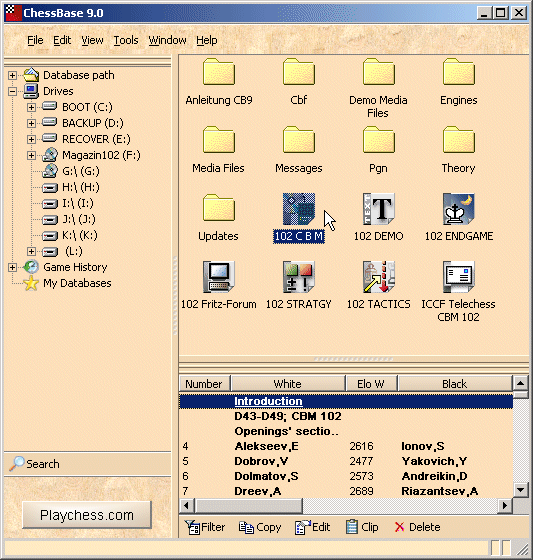
The directory “Updates” has a subdirectory “Fritz8” which contains a file called “GUI8.iup”. It is also not displayed in ChessBase but should be copied into the Fritz 8 directory on your hard disk (which is usually called ChessProgramm8). After copying GUI8.iup there start the program IUpgrade.exe by double-clicking it in the Windows Explorer. This will install the contents of the upgrade file and bring Fritz 8 to the latest state. Note that you must have Fritz 8 installed on your hard disk in order to execute the upgrade.
The directories \CBF and \PGN contain the games files in the old ChessBase format and in the international text format PGN. If you double-click these directories the contents will be displayed in ChessBase, but if you are using version 8 or higher there is no need to start these, since ChessBase will be more efficient using the current “CBH” format.
The database icon labelled “102 CBM” is the one that contains the main body of games in this format. To start or open this file you should double-click the icon (or click it and hit Enter, or right-click the icon and click “Open”). You will get a list of the 1334 games and three reports contained in this magazine. Over 400 of the games are annotated. How you can handle this list in the new ChessBase is the subject of another article in this magazine.
A good way to get an overview of the material on ChessBase Magazine 102 is to click on the “Tournament” tab at the top of the list. If you already have ChessBase 9.0 you will be pleasantly surprised. Instead of a simple list of the different tournaments which you can sort by right-clicking, now we have three window “panes”.
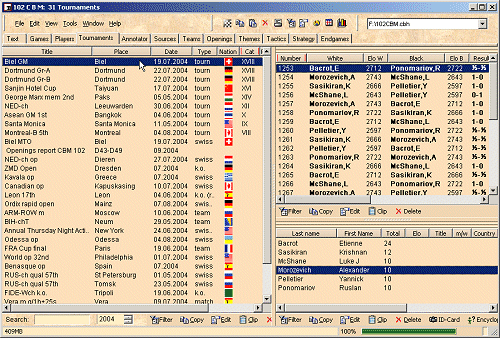
The tournament list of ChessBase 9.0 (click to enlarge)
On the left is the list of tournaments, just like in ChessBase 8, except that now you can sort the list by simply clicking on the column headers. In our picture we have clicked on “Category” to get the strongest tournaments to the top. The strongest one, the Biel GM, is highlighted and its contents automatically displayed on the right. There you see the games (unnecessary to mention that a double-click on any of these will load the game for replay), and below that a list of the participants in the tournament. Double-clicking an entry or pressing “T”, as before, will produce a cross table of the tournament.
Note that you can search for a tournament by typing one or two letters of the tournament name into the input box at the bottom left. This is not so relevant here, because the number of tournaments is manageable. But in a very large database it is invaluable. If you do not know the exact name of the tournament you can click on “Filter” at the bottom and type in a part of it. For instance searching for “Marx” will get the George Marx mem 2nd tournament, and “mund” will produce both the Dortmund events.
Tournaments
The nominally strongest tournaments in the CBM 102 are the category XVIII Biel GM, which we were looking at above, and the Dortmund Sparkassen Chess-Meeting, which had Anand, Svidler, Kramnik and Leko participating.
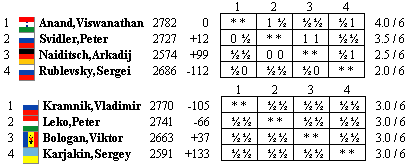
Dortmund saw the amazing spectacle of one group drawing every single one of their games in Group B. The qualifiers for the semifinals had to be decided in the rapid and blitz playoffs. In this issue of ChessBase Magazine we only have the games of the qualifiers. The semi-finals and finals will be provided in ChessBase Magazine 103.

A completely different picture was presented in Biel, where every single player had at least 50% of his games decided. Alexander Morozevich and Krishnan Sasikiran played an important role in this respect.

The other major event was the FIDE world championship in Tripoli. A number of top players were absent, most notably Kasparov, Anand and Kramnik. Still there were many memorable games, some brought about by the faster time control and the tension of having to survive two-game knockout matches. Here a description of what can go astray.
Multimedia
With ChessBase 9.0 replaying the multimedia files is very simple: just double-click the “Media” folder and you will see the two video files that you can replay from within ChessBase.

A double-click on the media symbol will open a board and start the video. In the first interview, with Vishy Anand immediately after the Dortmund tournament (which he won) there is no need for the chessboard.
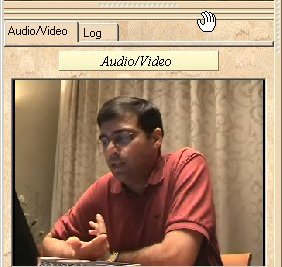
So you can “undock” the video window by simply grabbing the top of the window and moving it to some other part of the screen. There it can be resized at will. To get it back on the board simply close the window or double-click the blue bar at the top of the window.

The second video is an interview with the 14-year-old chess wunderkind from Ukraine, who at 12 became the youngest grandmaster (by a good margin) in the history of the game. Sergey had just come on a visit to Hamburg from the Dortmund tournament and did a live discussion on Playchess.com. The subject was his heart-stopping near win against Vladimir Kramnik in the event.

Here you will want to keep the board attached to the window (you can move it to a different place and resize it), because Sergey moves the pieces on the board, showing us what happened in the game. This video demonstrates the full power of the Chess Media System, where players and teacher do not just speak, they move pieces, draw arrows or mark squares. Everything is replayed synchronously on the board when the Windows Media file is started in ChessBase 9.0 (or Fritz 8).
What do you do if you do not have either of these programs? You can use the Windows File Explorer to locate the WMV file (remember, it’s in the directory \media) and start it in Windows. This only requires that you have the Windows Media Player 9 or higher installed on your computer. This is standard in all Windows XP systems, while users with older operating systems can download and install the Media Player 9 from the Microsoft site free of charge. It is highly recommended that you do so, since the quality of the videos and sound, compared to our previous compression techniques, is quite remarkable.
While we are at it you might want to browse around the other two directories that contain media files. In the directory Demo Media Files you will find four snippets from our latest multimedia training CDs. Two – by GM Matthias Wahls and chess trainer Gisbert Jacoby – are in German, but you can get a first impression of the new Fritz Trainer series. Start the file Aagaard Exercise Nr. 48.wmv for a section of Jacob Aagaard: Attacking Chess, or Martin Berlin1.wmv to see a lesson from Andrew Martin’s latest CD.
Theory
B33: Sveshnikov Sicilian
The basic position of the variation in Dorian Rogozenko’s article occurs after the moves 1.e4 c5 2.Nf3 Nc6 3.d4 cxd4 4.Nxd4 Nf6 5.Nc3 e5 6.Ndb5 d6 7.Bg5 a6 8.Na3 b5 9.Nd5 Be7 10.Bxf6 Bxf6 11.c3 Bg5 12.Nc2 0-0 13.a4 bxa4 14.Rxa4 a5 15.Bb5 Ne7.

In the past few years the variation starting with Smyslov’s move 15.Bb5 has become as popular as the main line 15.Bc4. After 15.Bb5, Black’s reply 15...Ne7 has established itself as the best answer. It must be mentioned right from the very beginning that the entire strategic battle in such positions is connected with the control over the square d5. White must establish there a knight or a bishop, which cannot be disturbed by opponent’s pieces, while Black must obviously prevent that. It is also important for White to avoid the exchange of Black’s dark-squared bishop for any of his knights. The logic is simple – the bishop from g5 cannot fight directly for the square d5 and therefore is often left out with no job.
After 15...Ne7 the most attractive way for White to continue fighting for the square d5 is to take opportunity of the fact that the pawn a5 is pinned and use the square b4 for the knight from c2. He can play either 16.Ncb4 at once, or first take on e7 with 16.Nxe7+. The moves often transpose to the same positions. 16.Nce3 is a strategical inaccuracy because of 16...Bxe3 with comfortable equality. Somewhat better is 16.Bc4, but moving the bishop onwards and backwards in the opening cannot pretend to offer White opening advantage.
Rogozenko’s conclusion in this article: The entire system starting with 9.Nd5 aims to offer White a small, but lasting initiative in a very safe type of positions thanks to a better control over the central square d5. However, in the Smyslov Variation (15.Bb5) after 15...Ne7 even if White succeeds to reach his goal and keep control over square d5, his advantage is often rather insignificant. Moreover, as the present survey shows, in practice Black has developed very precise ways to neutralize completely any attempts of White players to get even a small advantage. Both 16.Ncb4 Bd7 (or 16...Bh3) and 16.Nxe7+ Qxe7 17.Nb4 Bg4 (or 17...Bh3) lead to positions where Black has nothing to fear. This means that in spite of its popularity and efforts of some White players to achieve advantage with 15.Bb5, Black is able to completely solve all opening problems starting with 15...Ne7.
C40: Elephant Gambit
Peter Leisebein of Leipzig, Germany, has provided an article on the opening that begins with the moves 1.e4 e5 2.Nf3 d5. The name “Elephant Gambit” comes from Danish chess circles, an is supposed to illustrate the role of the two bishops, which often decide how things will go in these games.

The author has himself often tested out the gambit, especially in correspondence games. I would not recommend this defense for very important games, but if from time to time you wish to escape from generally fashionable openings, you will have a good canvas here on which to try out some creative ideas. In over the board chess, in rapid chess and especially in blitz chess, this gambit is a good surprise weapon. It is somewhat of a positional risk in correspondence chess, but even there Black has some chances, as can be seen from some games that I have played in recent years.
E05: Catalan
The start position of the variation of GM Zoltan Ribli’s article can be found after the moves 1.d4 Nf6 2.c4 e6 3.g3 d5 4.Bg2 Be7 5.Nf3 0-0 6.0-0 dxc4 7.Qc2 a6 8.a4 Bd7 9.Qxc4 Bc6 10.Bf4 a5 11.Nc3 Na6.
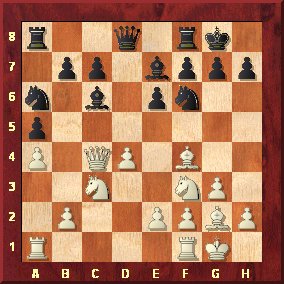
White has already tried seven variations here, but in them all there is a single main strategical idea – sooner or later he would like to occupy the center with e2-e4.
White’s moves are 12.Ne5, 12.Qd3, 12.Rad1, 12.Rfd1, 12.Rae1, 12.Rfe1 and above all 12.Rac1. Ribli’s conclusion at the end of the article: In this variation there are fewer sample games than in the variation with 10.Bg5. This is perhaps the reason why White has recently been avoiding the long main lines (10.Bg5) and wanting to play something different: 10.Bf4. Naturally Black has some alternatives to 10...a5 and 11...Na6, but playing against the weakened b4-square is a popular plan. In the first variation Black has no particular problems in equalizing. White can only hope for an opening advantage in the variation with 12.Rfe1 and 13.Rac1 or vice versa with 12.Rac1 and 13.Rfe1, because White has to play for e2-e4. In my personal opinion 13...Ld6 contains Black's best chance for equality.
E76: King's Indian: Four Pawn Attack
After the moves 1.d4 Nf6 2.c4 g6 3.Nc3 Bg7 4.e4 d6 5.f4 0-0 6.Nf3

we have the starting point for the sharp Four Pawns Attack, one of the most dangerous weapons against the King’s Indian Defense. The best answer is supposed to be immediate attack on the strong white pawn center with 5...c5. In his contribution, however, Jerzy Konikowski concerns himself with a side line which is also played from time to time: 6...e5. “Black sacrifices a pawn, hoping to achieve off the cuff some counter play in the center of the board. But in my opinion, simple developing moves allow White to gain a palpable advantage. The most appropriate way appears to be 7.dxe5 dxe5 8.Qxd8 Rxd8 9.Nxe5 with a preponderance in the center for White.”
Endgame
Due to illness the endgame section by Karsten Müller is smaller than usual this time, containing just 14 games. The first six are “training positions”, which means that a dialog box opens when you load the position, and you get a certain amount of time to find the best move. The commentary is in English and German.

A topical endgame training lesson where you have three minutes to find the correct move
Strategy
“Focus on the Centre” is the name of GM Peter Wells’ new mini-series, in which he will be trying to get back to basics by putting the centre firmly in the spotlight. “I want to take a look at the handling of various types of pawn structure in the centre, and how they affect planning, determine which pieces will flourish in the struggle.” He will deal with topics he feels have something of particular note to offer, or those which have been relatively neglected in the literature.
Tactics
GM Valery Atlas calls his tactical positions “Summer Collection” and writes: “Selecting training examples for the present database, I was impressed by the number of spectacular tactical battles, played in the summer months – many terrific combinations, powerful strikes and impressive mate finals. I hope that working on them will improve your calculation skills and keep you tactically fit.”
ICCF Telechess
The database has been compiled by the ICCF and starts with nine texts with news and tables. After that there are over 2700 games, including the complete 16th world championship, which was won by Tunc Hamarat.


 Contents of ChessBase Magazine 102
Contents of ChessBase Magazine 102












